中山大学2014软件学院计算机网络期中考试题目
中山大学2014年软件学院硕士研究生复试录取结果(更新)
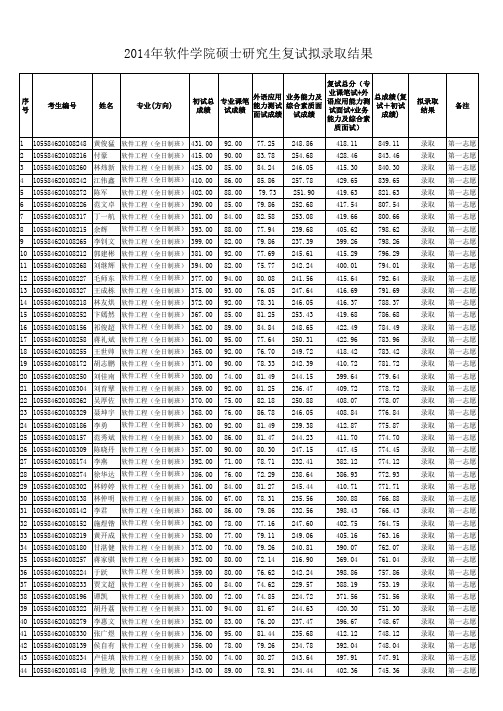
248.86 254.68 246.05 257.78 251.90 252.68 253.08 239.68 237.39 245.61 242.24 241.56 247.64 246.05 253.43 248.65 250.31 249.72 242.39 244.15 236.47 250.88 246.05 239.38 244.23 247.15 232.41 238.64 245.44 235.56 232.56 247.60 249.06 240.81 216.90 242.24 229.57 224.72 244.63 237.47 235.68 234.78 243.64 234.44
418.11 428.46 415.30 429.65 419.63 417.54 419.66 405.62 399.26 415.29 400.01 415.64 416.69 416.37 419.68 422.49 422.96 418.42 410.72 399.64 409.72 408.07 408.84 412.87 411.70 417.45 382.12 386.93 410.71 380.88 398.43 402.75 405.16 390.07 369.04 398.86 388.19 371.56 420.30 396.67 412.12 392.04 397.91 402.36
中山大学计算机网络课平时作业(2)及参考答案

中⼭⼤学计算机⽹络课平时作业(2)及参考答案
计算机⽹络(09DE)
作业3参考答案
⽹络层
1、IP分组的头部长度≤ B,选项长度≤ B,整个IP分组长度≤ B。
答:60,40,65535
2、针对因特⽹的⽹络层,以下说法是否正确:(多选)
(a) 该层提供⽆连接的不可靠的尽⼒服务;
(b) ⼀台源主机发往同⼀⽬标主机的多个IP分组将会经过相同的路由器到达⽬的地;
(c) ⼀个IP分组被中间路由器分拆成多个⽚段(fragment),它们将会经过相同的路由器到
达⽬的地;
(d) ⽬的主机发现IP分组的某个⽚段丢失后则丢弃整个分组;
(e) 中间的路由器既将分组拆分为⽚断也负责⽚段重组;
答:(a)(d)
3、IP协议是如何防⽌分组⼀直在⽹上绕圈的?
答:采⽤TTL,经过⼀个路由器将减1,减⾄0将被丢弃,并⽤ICMP分组通告源主机.
4、⼀个路由器收到⼀个⽆选项的IP分组(协议号=6,TTL=60,TOS=0,没有选项,标识=26208,源地址=192.168.1.120,⽬标地址=172.16.45.96,Payload的长度为4000),现在需要将该分组转发到⼀个以太⽹上(MTU=1500), 该路由器将如何分段,先填写原分组的值,然后写出拆分后各个⽚断的字段值。
5、指出以下IP地址的类别(A,B,C,D类),并分别说明它们的⽹络号和主机号:
(a) 66.144.54.160
(b) 190.168.1.34
(c) 218.30.66.5
(d) 192.168.1.1
答:类别⽹络号主机号
(a) A类 66 144.54.160
中山大学14A软件学院研究生论文导师一览表(2)
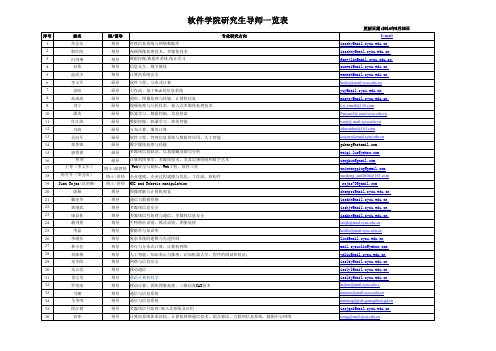
1常会友博导管理信息系统与网络数据库isschy@
2朝红阳博导视频图像处理技术,多媒体技术isschhy@ 3冯剑琳博导数据挖掘,数据库系统,统计学习fengjlin@ 4孙伟博导信息安全、数字媒体sunwei@
5温武少博导计算机系统安全wenwsh@
6李文军硕导软件工程、分布式计算lnslwj@
7余阳硕导工作流、基于Web的信息系统yuy@,
8高成英硕导图形、图像处理与传输、计算机仿真mcsgcy@
9刘宁硕导视频处理与分析技术,嵌入式多媒体处理技术Ln_email@
10潘炎硕导机器学习,数据挖掘,信息检索Panyan5@
11任江涛硕导数据挖掘、机器学习、商务智能issrjt@
12万海硕导分布计算,服务计算whwanhai@
13吴向军硕导软件工程、管理信息系统与数据库应用、人工智能issxjwu@
14郑贵锋硕导数字媒体处理与传输gzheng@
15骆伟祺硕导多媒体信息取证、信息隐藏及隐写分析weiqi.luo@
16 曾坤硕导计算机图形学,多媒体技术,非真实感绘制和数字艺术zengkun@
17 王青(李文军)博士/副教授 Web安全与隐私,Web工程,软件工程ericwangqing@
18孙雪冬(常会友)博士/讲师企业建摸,企业过程建摸与优化,工作流,软构件xuedong_sun2004@ 19Juan Rojas(冯剑琳)博士/讲师HRI and Robotic manipulation rojas70@
20陈佩博导图像理解与计算机视觉chenpei@ 21戴宪华博导通信与数据挖掘issdxh@ 22黄继武博导多媒体信息安全isshjw@, 23康显桂博导多媒体信号处理与通信,多媒体信息安全isskxg@ 24赖剑煌博导生物特征识别,模式识别,图象处理stsljh@
(NEW)中国传媒大学《821数据结构》与计算机网络历年考研真题汇编
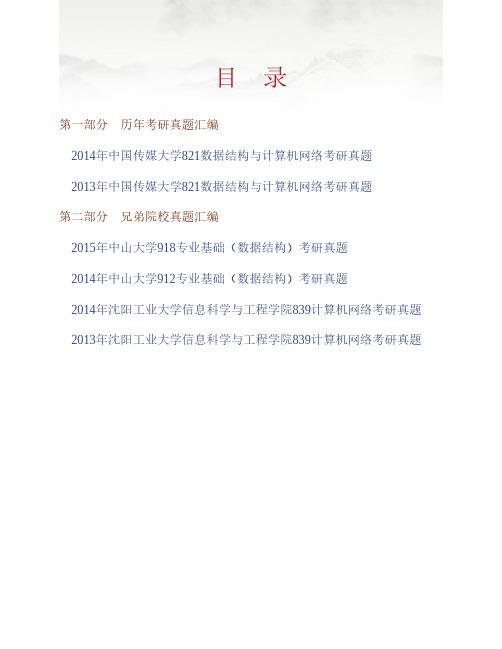
目 录
第一部分 历年考研真题汇编
2014年中国传媒大学821数据结构与计算机网络考研真题
2013年中国传媒大学821数据结构与计算机网络考研真题
第二部分 兄弟院校真题汇编
2015年中山大学918专业基础(数据结构)考研真题
2014年中山大学912专业基础(数据结构)考研真题
2014年沈阳工业大学信息科学与工程学院839计算机网络考研真题2013年沈阳工业大学信息科学与工程学院839计算机网络考研真题
第一部分 历年考研真题汇编
2014年中国传媒大学821数据结构与计算机网络考研真题
2013年中国传媒大学821数据结构与计算机网络考
研真题
第二部分 兄弟院校真题汇编
2015年中山大学918专业基础(数据结构)考研真题
2014年中山大学912专业基础(数据结构)考研真
题
2014年沈阳工业大学信息科学与工程学院839计算
机网络考研真题
2013年沈阳工业大学信息科学与工程学院839计算
机网络考研真题
中大计算机课程安排
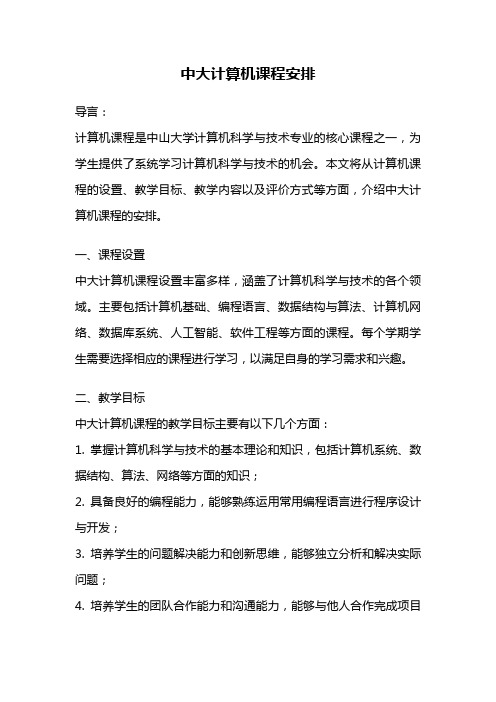
中大计算机课程安排
导言:
计算机课程是中山大学计算机科学与技术专业的核心课程之一,为学生提供了系统学习计算机科学与技术的机会。本文将从计算机课程的设置、教学目标、教学内容以及评价方式等方面,介绍中大计算机课程的安排。
一、课程设置
中大计算机课程设置丰富多样,涵盖了计算机科学与技术的各个领域。主要包括计算机基础、编程语言、数据结构与算法、计算机网络、数据库系统、人工智能、软件工程等方面的课程。每个学期学生需要选择相应的课程进行学习,以满足自身的学习需求和兴趣。
二、教学目标
中大计算机课程的教学目标主要有以下几个方面:
1. 掌握计算机科学与技术的基本理论和知识,包括计算机系统、数据结构、算法、网络等方面的知识;
2. 具备良好的编程能力,能够熟练运用常用编程语言进行程序设计与开发;
3. 培养学生的问题解决能力和创新思维,能够独立分析和解决实际问题;
4. 培养学生的团队合作能力和沟通能力,能够与他人合作完成项目
开发;
5. 培养学生的实践能力,能够应用所学知识解决实际问题。
三、教学内容
1. 计算机基础课程:包括计算机组成原理、操作系统、计算机网络等方面的课程。通过这些课程的学习,学生将了解计算机的基本组成和工作原理,掌握计算机操作系统的基本功能和使用方法,了解计算机网络的基本概念和协议。
2. 编程语言课程:包括C语言、Java、Python等编程语言的学习。通过这些课程的学习,学生将学会编写简单的程序和算法,培养良好的编程思维和习惯。
3. 数据结构与算法课程:包括线性表、树、图等数据结构和排序算法、查找算法等基本算法的学习。通过这些课程的学习,学生将掌握常用数据结构和算法的原理和应用,能够解决实际问题。
中山大学2014-2015学年度国家奖学金本科学
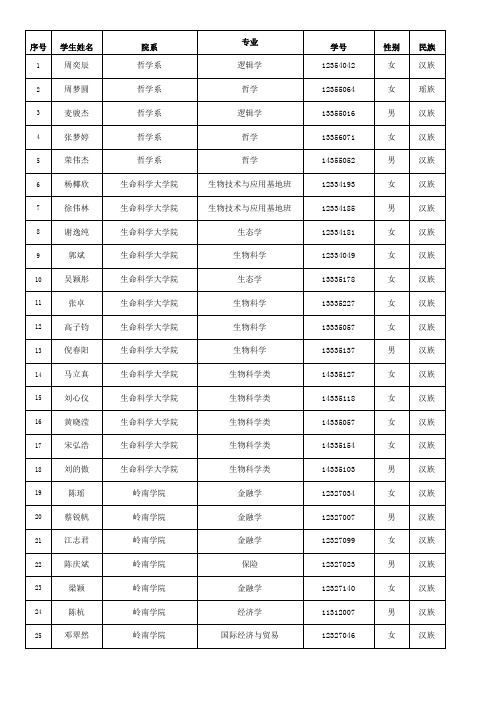
129
130
邱培培 朱佳丽 黄淇 黄越 李萌 王钰琦 蓝若瑜 林寄瑶 陶凤 胥国防
许蓉 吴燕楚 曾旸 查瑜 纪翔 施展 苏晓煌 吴泽儒 梁东宝 刘金欣 罗程祎 王雎
环境科学与工程学院 环境科学与工程学院 环境科学与工程学院 环境科学与工程学院 环境科学与工程学院 环境科学与工程学院 环境科学与工程学院 环境科学与工程学院 环境科学与工程学院 环境科学与工程学院 教育学院 教育学院 教育学院 物理科学与工程技术学 院 物理科学与工程技术学 院 物理科学与工程技术学 院 物理科学与工程技术学 院 物理科学与工程技术学 院 物理科学与工程技术学 院 物理科学与工程技术学 院 物理科学与工程技术学 院 物理科学与工程技术学 院 物理科学与工程技术学 院 物理科学与工程技术学 院 物理科学与工程技术学 院
汉族 汉族 汉族 汉族 汉族 汉族 汉族 汉族 土家族 汉族 汉族 汉族 汉族 汉族 汉族 汉族 汉族 汉族 汉族 汉族 汉族 汉族 汉族 汉族 汉族 汉族
105
106
107
108
109
110
111
112
113
114
115
116
汪其涛
12309044
117
邓紫坤
14309005
118
左宇航
14311060
38
39
中山大学自考计算机及应用专业
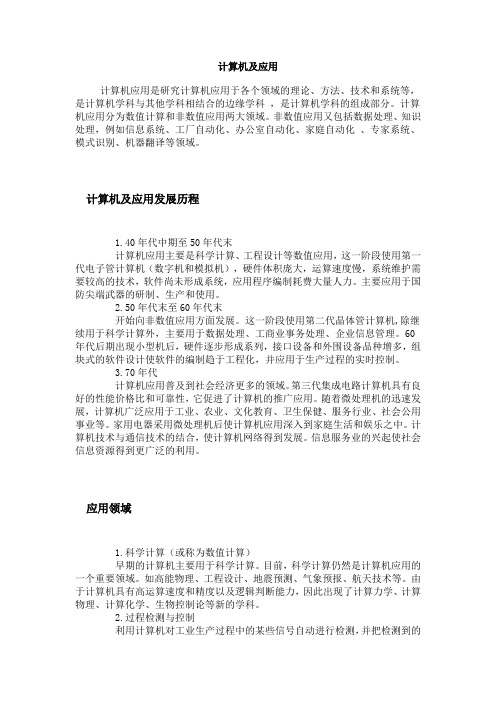
计算机及应用
计算机应用是研究计算机应用于各个领域的理论、方法、技术和系统等,是计算机学科与其他学科相结合的边缘学科,是计算机学科的组成部分。计算机应用分为数值计算和非数值应用两大领域。非数值应用又包括数据处理、知识处理,例如信息系统、工厂自动化、办公室自动化、家庭自动化、专家系统、模式识别、机器翻译等领域。
计算机及应用发展历程
1.40年代中期至50年代末
计算机应用主要是科学计算、工程设计等数值应用,这一阶段使用第一代电子管计算机(数字机和模拟机),硬件体积庞大,运算速度慢,系统维护需要较高的技术,软件尚未形成系统,应用程序编制耗费大量人力。主要应用于国防尖端武器的研制、生产和使用。
2.50年代末至60年代末
开始向非数值应用方面发展。这一阶段使用第二代晶体管计算机,除继续用于科学计算外,主要用于数据处理、工商业事务处理、企业信息管理。60年代后期出现小型机后,硬件逐步形成系列,接口设备和外围设备品种增多,组块式的软件设计使软件的编制趋于工程化,并应用于生产过程的实时控制。
3.70年代
计算机应用普及到社会经济更多的领域。第三代集成电路计算机具有良好的性能价格比和可靠性,它促进了计算机的推广应用。随着微处理机的迅速发展,计算机广泛应用于工业、农业、文化教育、卫生保健、服务行业、社会公用事业等。家用电器采用微处理机后使计算机应用深入到家庭生活和娱乐之中。计算机技术与通信技术的结合,使计算机网络得到发展。信息服务业的兴起使社会信息资源得到更广泛的利用。
应用领域
1.科学计算(或称为数值计算)
早期的计算机主要用于科学计算。目前,科学计算仍然是计算机应用的一个重要领域。如高能物理、工程设计、地震预测、气象预报、航天技术等。由于计算机具有高运算速度和精度以及逻辑判断能力,因此出现了计算力学、计算物理、计算化学、生物控制论等新的学科。
大学生计算机应用能力A级考试
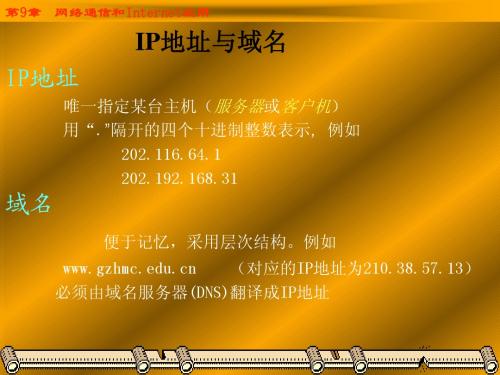
(4)娱乐 ) 网络通信和Internet Internet应用 第9章 网络通信和Internet应用 WWW.AVL.COM.CN 世纪前线 世纪前线(测试直通车 测试直通车) 世纪前线 测试直通车 http://benchmark.avl.com.cn QQ530音乐网 http://www.qq530.com/ 音乐网 WWW.520MUSIC.COM 我爱音乐网 WWW.3320.NET 爬爬书库 http://smt3.cn/ 黄金书屋 WWW.HJSM.NET 幻剑书盟 WWW.BOOKSKY.ORG 快眼看书 中国游戏中心 WWW.CHINAGAMES.NET WWW.OURGAME.COM 联众世界 http://HOT.BTCHINA.NET 电影下载 皮皮电影网(全国最大电影网 全国最大电影网) http://www.pipi.cn/ 皮皮电影网 全国最大电影网 NBA中文官方网 http://nba.tom.com/ 中文官方网 http://www.game2.cn/ 网页游戏平台 http://www.17173.com/ 网络游戏第一门户站 跟我学FLASH http://www.gwxflash.com/index.asp 跟我学 http://www.ip138.com/ 查询网 http://www.21softs.com/ 百年日历表 http://www.meet99.com/map 卫星地图 http://www.3lian.com/ 网页素材 K190动漫 http://www.k190.com/ 动漫
中山大学软件学院2014学年秋季学期课表

上课时间 星期六 星期天
选修 1-8
32
4
2
2-5
选修 1-8
32
4
2
7-10
选修 10-17 32
4
2
2-5
必修 10-17 32
4
2
7-10
备注: 1、上课时间:本学期正式上课从 9 月 21 日(周日)开始,共 18 周,其中第 9、18 周为考试时间。
2、上课时段:请查看“中山大学 2012 学年度上课时段设置一览表”。
中山大学软件学院软件工程硕士研究生课程表 (MSE'13B, FALL 2014)
上课地点Байду номын сангаас南校区
序号 年级
课程名称
1 13B 2 13B 3 13B 2 13B
MSE-309
CMM 实践 MSE-210
信息安全技术 MSE-240
数字图像处理 MSE-201
系统分析与设计
课程 类别
周时 总学时 周学时 学分
教师 马仁勇高工
孙伟教授 曾坤博士 衣杨副教授
听课 人数
上课教室 与实验室
南校区第一教学 50 楼 1307
南校区第一教学 50 楼 1307
南校区第一教学 50 楼 1307
50
南校区第一教学 楼 1307
计算机网络作业1
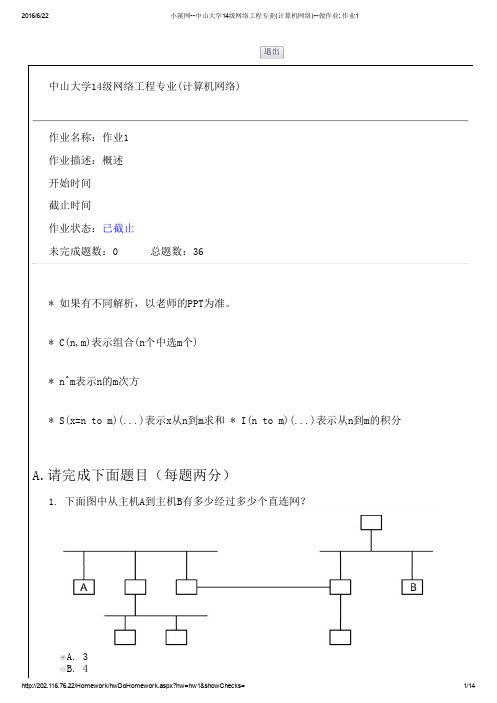
3/14
2016/6/22
(2 points)
score:√
Answer: C
小溪网中山大学14级网络工程专业(计算机网络)做作业: 作业1
赞[0] 踩[0] 求讲解[0] 问老师
8. 电话使用了以下哪种传输方式? A.full-duplex B.half-duplex C.simplex D.none
http://202.116.76.22/Homework/hwDoHomework.aspx?hw=hw1&showChecks=
4/14
2016/6/22
(2 points)
score:√
Answer: D
小溪网中山大学14级网络工程专业(计算机网络)做作业: 作业1
赞[0] 踩[0] 求讲解[0] 问老师
(2 points)
score:√
Answer: A
赞[0] 踩[1] 求讲解[5] 问老师
9. 实验室一般采用以下哪种连网方式? A.SAN B.LAN C.MAN D.WAN
(2 points)
score:√
Answer: B
赞[0] 踩[0] 求讲解[wk.baidu.com] 问老师
10. 因特网属于以下哪种网络? A.SAN B.LAN C.MAN D.WAN
赞[0] 踩[1] 求讲解[0] 问老师
精品资料大放送
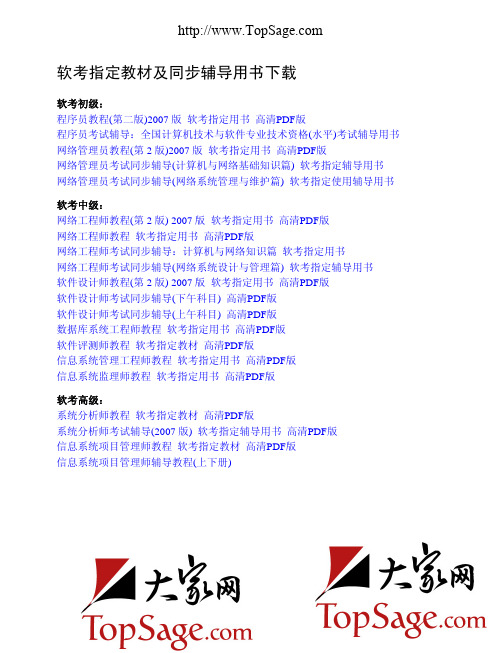
软考指定教材及同步辅导用书下载
软考初级:
程序员教程(第二版)2007版软考指定用书高清PDF版
程序员考试辅导:全国计算机技术与软件专业技术资格(水平)考试辅导用书网络管理员教程(第2版)2007版软考指定用书高清PDF版
网络管理员考试同步辅导(计算机与网络基础知识篇) 软考指定辅导用书
网络管理员考试同步辅导(网络系统管理与维护篇) 软考指定使用辅导用书
软考中级:
网络工程师教程(第2版) 2007版软考指定用书高清PDF版
网络工程师教程软考指定用书高清PDF版
网络工程师考试同步辅导:计算机与网络知识篇软考指定用书
网络工程师考试同步辅导(网络系统设计与管理篇) 软考指定辅导用书
软件设计师教程(第2版) 2007版软考指定用书高清PDF版
软件设计师考试同步辅导(下午科目) 高清PDF版
软件设计师考试同步辅导(上午科目) 高清PDF版
数据库系统工程师教程软考指定用书高清PDF版
软件评测师教程软考指定教材高清PDF版
信息系统管理工程师教程软考指定用书高清PDF版
信息系统监理师教程软考指定用书高清PDF版
软考高级:
系统分析师教程软考指定教材高清PDF版
系统分析师考试辅导(2007版) 软考指定辅导用书高清PDF版
信息系统项目管理师教程软考指定教材高清PDF版
信息系统项目管理师辅导教程(上下册)
软考历年真题及答案汇总
2007年上半年试题分析与解答软考指定用书清华出版(含各科) 2007年下半年软考网络工程师试题 Word版
2007年下半年信息系统项目管理师试题 Word版
2007年下半年信息系统监理师试题 Word版
《中山大学408计算机学科专业基础综合历年考研真题及答案解析》11.3

目录
Ⅰ历年考研真题试卷 (2)
中山大学2010年招收攻读硕士学位研究生入学考试试题 (2)
中山大学2012年招收攻读硕士学位研究生入学考试试题 (8)
中山大学2013年招收攻读硕士学位研究生入学考试试题 (15)
中山大学2014年招收攻读硕士学位研究生入学考试试题 (22)
中山大学2015年招收攻读硕士学位研究生入学考试试题 (29)
中山大学2016年招收攻读硕士学位研究生入学考试试题 (33)
Ⅱ历年考研真题试卷答案解析 (39)
中山大学2010年招收攻读硕士学位研究生入学考试试题答案解析 (39)
中山大学2012年招收攻读硕士学位研究生入学考试试题答案解析 (54)
中山大学2013年招收攻读硕士学位研究生入学考试试题答案解析 (69)
中山大学2014年招收攻读硕士学位研究生入学考试试题答案解析 (83)
中山大学2015年招收攻读硕士学位研究生入学考试试题答案解析 (98)
Ⅰ历年考研真题试卷
中山大学2010年招收攻读硕士学位研究生入学考试试题
考试科目:908专业基础(数据结构)
答题说明:所有答案必须写在答题纸上,并写清楚题号,写在试题上无效。
备注:中山大学软件工程(专业学位)专业往年考的是专业基础(数据结构)科目,本真题编写的是专业基础(数据结构)科目的试题及答案解析,2017年专业基础(数据结构)科目变为408计算机学科专业基础综合。
一、单项选择题(每小题2分,共30分)
1、下面说法错误的是()
(1)算法的空间复杂度是指算法执行过程中所需要的存储空间
(2)在相同的规模n 下,复杂度O (n )的算法在时间上总是优于复杂度)2(n O 的算法(3)算法的可行性是指指令不能有二义性
中山大学数据科学与计算机学院计算机技术考研复试面试真题及答案总结
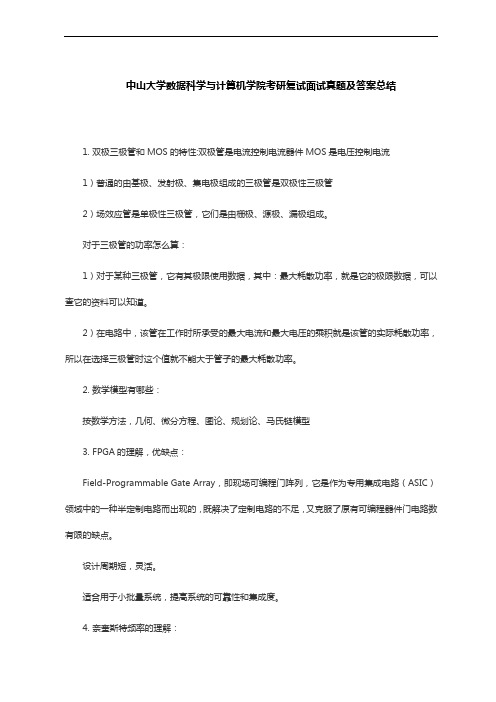
中山大学数据科学与计算机学院考研复试面试真题及答案总结
1. 双极三极管和MOS的特性:双极管是电流控制电流器件MOS是电压控制电流
1)普通的由基极、发射极、集电极组成的三极管是双极性三极管
2)场效应管是单极性三极管,它们是由栅极、源极、漏极组成。
对于三极管的功率怎么算:
1)对于某种三极管,它有其极限使用数据,其中:最大耗散功率,就是它的极限数据,可以查它的资料可以知道。
2)在电路中,该管在工作时所承受的最大电流和最大电压的乘积就是该管的实际耗散功率,所以在选择三极管时这个值就不能大于管子的最大耗散功率。
2. 数学模型有哪些:
按数学方法,几何、微分方程、图论、规划论、马氏链模型
3. FPGA的理解,优缺点:
Field-Programmable Gate Array,即现场可编程门阵列,它是作为专用集成电路(ASIC)领域中的一种半定制电路而出现的,既解决了定制电路的不足,又克服了原有可编程器件门电路数有限的缺点。
设计周期短,灵活。
适合用于小批量系统,提高系统的可靠性和集成度。
4. 奈奎斯特频率的理解:
离散信号系统采样频率的一半,采样定理指出,只要离散系统的奈奎斯特频率高于采样信号的最高频率或带宽,就可以避免混叠现象。
5. 诺尔曼结构的特点是什么?
答:(1)采用存储程序方式
(2)存储器是按地址访问的线性编址的一维结构,每个单元的位数是固定的
(3)指令由操作码和地址码组成的
(4)通过执行指令直接发出控制信号控制计算机的操作
(5)机器以运算器为中心,输入输出设备与存储器间的数据传送都通过运算器
中山大学计算机与网络实验实验基础(1)
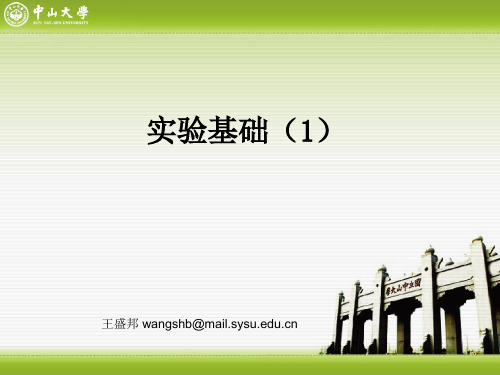
18
判断主机是否在同一网段
IP地址:172.16.30.100
10101100 00010000 00011110 01100100 逻辑与
子网掩码 :255.255.192.0
网络号:172.16.0.0
11111111 11111111 11000000 00000000 结果 10101100 00010000 00000000 00000000
(3)C类空间不够时,则只能分配B类网络IP给主机使用, 类似于第1种情况的计算,有可能浪费空间更大:浪费216-N
13
子网掩码与子网划分
• 子网掩码:是一个与IP地址相对应的32位的数,掩码中的 各个位与IP地址的各个位相对应 • 如果IP地址的一个位对应的子网掩码位为1,那么该IP地 址的位属于地址的网络部分。如果IP地址中的一个位对应 的子网掩码比特为0,那么该IP地址位属于主机部分
192.168.0.0~192.168.255.255 256个连续的C类地址 这些私有地址常被用于局域网内部地址
10
IPv4地址特殊表示
• 网络地址(“0”地址) 主机号全为0的IP地址表示某网络号的网络本身 • 广播地址(“1”地址) 主机号各位全为1的IP地址表示本网广播或称为本地 广播 • 回环地址 A类地址第一段十进制数值为127是保留地址,用于 环路反馈等测试。如127.0.0.1代表本机地址 • 全“0”地址 整个IP地址全为0代表一个未知的网络如:0.0.0.0。 在路由器的配置中,用于默认路由的配置
计算机期中考试试题
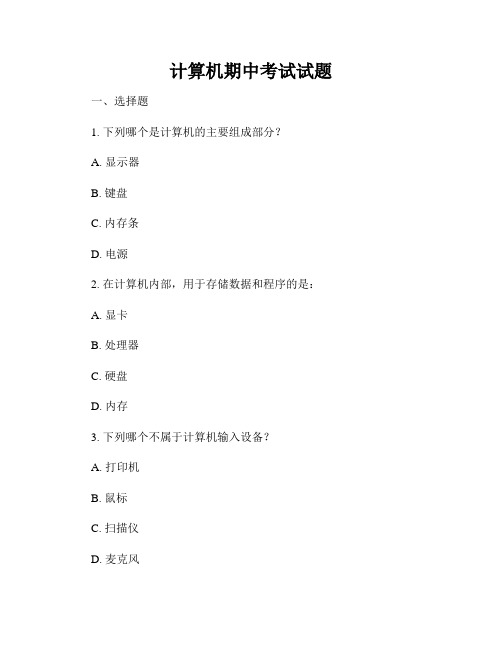
计算机期中考试试题
一、选择题
1. 下列哪个是计算机的主要组成部分?
A. 显示器
B. 键盘
C. 内存条
D. 电源
2. 在计算机内部,用于存储数据和程序的是:
A. 显卡
B. 处理器
C. 硬盘
D. 内存
3. 下列哪个不属于计算机输入设备?
A. 打印机
B. 鼠标
C. 扫描仪
D. 麦克风
4. 计算机内部数据的传输方式是使用:
A. 电流
B. 光纤
C. 无线信号
D. 机械振动
5. 下列哪个程序可以用来创建和编辑文档?
A. Photoshop
B. Excel
C. PowerPoint
D. Word
二、填空题
1. 计算机内部的最基本单位是____。
2. 计算机的运算速度与____有关。
3. ____是计算机存储数据的最主要设备。
4. 编写计算机程序的语言称为____。
5. 计算机网络是由____连接而成的。
三、简答题
1. 简述计算机硬件和软件的区别与联系。
2. 什么是操作系统?它的作用是什么?
3. 简述计算机网络的优点和应用领域。
4. 什么是计算机病毒?如何避免计算机病毒的感染?
5. 简述计算机的工作原理。
四、应用题
1. 设计一个程序,实现两个数的相加运算,并输出结果。
2. 请编写一个程序,询问用户姓名并打印出“欢迎XXX”的问候语。
3. 编写一个程序,要求用户输入一个整数n,然后输出1到n的所有偶数。
以上是计算机期中考试的试题,希望能帮助同学们更好地复习计算机知识,提升考试成绩。祝各位考试顺利!
中山大学_网络教育_信息安全技术_第一次作业非毕业班1作业答案
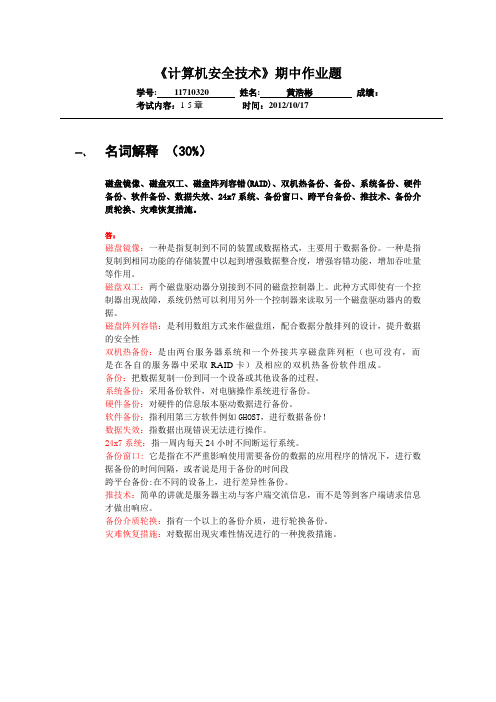
《计算机安全技术》期中作业题
学号: 11710320 姓名: 黄浩彬成绩:
考试内容:1-5章时间:2012/10/17
一、名词解释(30%)
磁盘镜像、磁盘双工、磁盘阵列容错(RAID)、双机热备份、备份、系统备份、硬件备份、软件备份、数据失效、24x7系统、备份窗口、跨平台备份、推技术、备份介质轮换、灾难恢复措施。
答:
磁盘镜像:一种是指复制到不同的装置或数据格式,主要用于数据备份。一种是指复制到相同功能的存储装置中以起到增强数据整合度,增强容错功能,增加吞吐量等作用。
磁盘双工:两个磁盘驱动器分别接到不同的磁盘控制器上。此种方式即使有一个控制器出现故障,系统仍然可以利用另外一个控制器来读取另一个磁盘驱动器内的数据。
磁盘阵列容错:是利用数组方式来作磁盘组,配合数据分散排列的设计,提升数据的安全性
双机热备份:是由两台服务器系统和一个外接共享磁盘阵列柜(也可没有,而是在各自的服务器中采取RAID卡)及相应的双机热备份软件组成。
备份:把数据复制一份到同一个设备或其他设备的过程。
系统备份:采用备份软件,对电脑操作系统进行备份。
硬件备份:对硬件的信息版本驱动数据进行备份。
软件备份:指利用第三方软件例如GHOST,进行数据备份!
数据失效:指数据出现错误无法进行操作。
24x7系统:指一周内每天24小时不间断运行系统。
备份窗口:它是指在不严重影响使用需要备份的数据的应用程序的情况下,进行数据备份的时间间隔,或者说是用于备份的时间段
跨平台备份:在不同的设备上,进行差异性备份。
推技术:简单的讲就是服务器主动与客户端交流信息,而不是等到客户端请求信息才做出响应。
- 1、下载文档前请自行甄别文档内容的完整性,平台不提供额外的编辑、内容补充、找答案等附加服务。
- 2、"仅部分预览"的文档,不可在线预览部分如存在完整性等问题,可反馈申请退款(可完整预览的文档不适用该条件!)。
- 3、如文档侵犯您的权益,请联系客服反馈,我们会尽快为您处理(人工客服工作时间:9:00-18:30)。
1.Bandwidth and Delay
a. On a generic multi-hop network, explain the potential causes of delay for a packet:
• Propagation delay:
• Transmission delay:
• Queueing delay:
• Processing delay:
b. For a fixed network path, which of these delays are constant over time, and which ones vary with load? Explain why.
c. (Estimating bottleneck bandwidth). An interesting technique used to estimate the bottleneck bandwidth in a network is called packet pair. The idea is simple: you send two packets back-to-back (no gap), at the full bandwidth of the first hop. The receiver at the other end can then determine the bandwidth by measuring the delay between the receptions of the two packets. In this problem we will do just that, with a simplified 3-link network shown in the figure below, with no extra traffic, no queues, and instantaneous access to the medium.
Setup: In the figure, assume there is no queueing or processing delay, and that nodes can forward a packet as soon as (a) all bytes for the packet have been received from the previous link, and (b) the outgoing link is free. All three links have a propagation delay of 10ms; link AB has a bandwidth of 10Mbps ((107 bits per second), and link CD has a bandwidth of 8 Mbps (8 × 106 bps). You send two probe packets of 1000 bytes each, as depicted in the figure.
(a) In this setup, calculate the length of the interval t1t2in the figure. Do the same for t3t4
(b) In the diagram, draw the transmission of the two packets in the link BC, paying attention to when they must start and when they must end.
(c) You measure the delay t4t5 between the end of the receptions of the two packets to be 8 ms. Assuming that the link BC is the bottleneck bandwidth in the path, what is its bandwidth? Explain your reasoning.
2.Answer the following questions regarding TCP, UDP, IP,
and routing:
a)What are the important fields in the TCP, UDP, and IP headers?
Without these fields, the protocols would clearly not “work”.
b)Sketch the TCP connection initiation and connection termination
packet flows using a timing diagram.
3.Socket Programming
3.1. Consider the following Java application:
socket = new DatagramSocket(12345);
while (true) {socket.receive(packet);} What happens if somebody decides to run two instances of this
application on one machine and 4 UDP segments arrive at port 12345?
a) both instances of the application receive all 4 segments
b) one instance receives all 4 segments
c) some segments are received by one instance, other segments
are received by the other instance
d) one instance receives segments 1 and 3, the other receives
segments 2 and 4
3.2.Given the following lines from a Java program segment:
byte[] dataOut = new byte [512];
String userInput = inFromUser.readLine();
dataOut = userInput.getBytes();
Which of the following lines of code could be used to create a new UDP datagram packet to send the data that was provided by the user to a host identified by the InetAddress object IPAddress?
a) DatagramPacket packetToSend = new
DatagramPacket(dataOut, dataOut.length, IPAddress)
b) UDPPacket = new UDPDatagram (userInput,
userInput.length, IPaddress, 9876)
c) DatagramPacket packet = new DatagramPacket(dataOut, dataOut.length, IPAddress, 9876)
d) Socket datagramSocket = new dataGramPacket(dataOut, IPAddress)
3.3.
Consider a server socket object
socket = ServerSocket(12345);
What does the invocation of socket.accept() return?
a) 'true' if there is a new TCP segment in the socket's buffer, false otherwise
